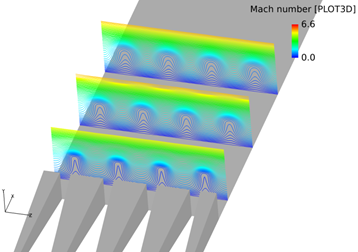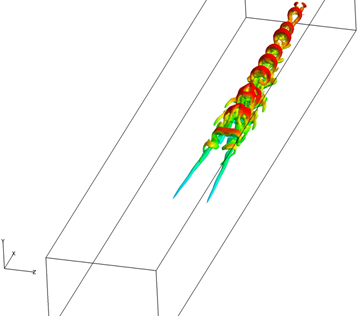Studies on nonlinear vortex dynamics in the later-stage of laminar-turbulent transition in compressible boundary layers
JAXA Supercomputer System Annual Report April 2016-March 2017
Report Number: R16E0047
- Responsible Representative: Kazuo Matsuura( Graduate School of Science and Engineering)
- Contact Information: Kazuo Matsuura(matsuura.kazuo.mm@ehime-u.ac.jp)
- Members: Kazuo Matsuura
- Subject Category: Basic Research(Numerical analysis,CFD,other )
Abstract
Boundary layer transition around a solid object is important in order to predict the condition for stable engine operation and the distribution of heat transfer when an airplane flies at the speed five times faster than the speed of sound. Vortex dynamics occurring inside the boundary layer is investigated usingsupercomputer. Also, mathematical techniques necessary for the investigation are also developed.
Goal
In hypersonic transitional flows, there are many complicated factors such as density fluctuation and temperature fluctuation due to the co-existence of the region slower than the speed of sound and the region faster than the speed of sound inside the boundary layer. Detailed investigations into the vortex dynamics occurring inside the boundary layers are expected. In this study, we aim to clarify the nonlinear vortex dynamics especially in the late-stage by conducting direct numerical simulations of laminar-turbulent transition in compressible boundary layers observed in hypersonic flows. Also, we develop a mathematical methodology to introduce vortices responsible for the late stage to the boundary layers, and its computational methods.
Objective
Direct numerical simulations of laminar-turbulent transition in hypersonic flows are conducted. Organized vortices and boundary-layer fluctuations are extracted based on the large-scale unsteady data, and its generation and deformation are discussed. The effects of various disturbances on the transition process are also investigated.
References and Links
N/A
Use of the Supercomputer
Initial- and boundary-value problems of Navier-Stokes equation are solved by the supercomputer varying initial values and/or boundary conditions. The supercomputer is also used to extract vortices from resultant large-scale data and analyze the vortices.
Necessity of the Supercomputer
For the investigation of boundary layer transition of hypersonic flows, numerical simulation is a central tool because measurement is difficult due to the existence of acoustical disturbance in a wind tunnel. Because boundary layer transition is susceptible to disturbance, and in addition transition is hard to occur due to strong compressibility, powerful supercomputers that enable high-accuracy large-scale computation are necessary to get results in a short time period.
Achievements of the Year
Vortex structures formed downstream of the array of protuberance placed in hypersonic flows, and secondary hairpin vortex generation in a transitional process
Publications
Peer-reviewed articles
1) K. Matsuura, ‘Direct numerical simulation of a straight vortex tube in a laminar boundary-layer flow,’ Int. J. Comp. Meth. and Exp. Meas., Vol. 4, No. 4, pp. 474-483 (2016).
2) K. Matsuura, ‘Evolution of a modelled hairpin vortex in a laminar-boundary-layer flow,’ 20th Australasian Fluid Mechanics Conference, Perth, Australia, 5-8 December, pp. 1-4 (2016).
3) K. Matsuura, ‘Research on the late-stage of laminar-turbulent transition,’ Proc. of the 6th Int. and 43rd Nat. Conf. on Fluid Mech. and Fluid Power, December 15-17th, MNNITA, Allahabad, U.P., India, pp. 1-6 (2016).
4) K. Matsuura, ‘DNS study on a tertiary instability process in the late stage of boundary-layer transition,’ Proc. of the 6th Int. and 43rd Nat. Conf. on Fluid Mech. and Fluid Power, December 15-17th, MNNITA, Allahabad, U.P., India, pp. 1-6 (2016).
5) K. Matsuura, ‘DNS study on the evolution of a hairpin-like vortex tube into a turbulent spot,’ Int. Conf. for Comput. Phys., Math. and Appl, (ICCPMA2016) November 7-8, Tokyo, Japan, pp. 1-9 (2016).
Presentations
1) K. Matsuura, Numerical analysis of a straight vortex tube in a laminar boundary-layer flow, ECCOMAS Congress 2016, 5-10 June Crete Island, Greece (2016).
Computational Information
- Parallelization Methods: Hybrid Parallelization
- Process Parallelization Methods: MPI
- Thread Parallelization Methods: Automatic Parallelization
- Number of Processes: 32
- Number of Threads per Process: 8
- Number of Nodes Used: 32
- Elapsed Time per Case (Hours): 110
- Number of Cases: 0
Resources Used
Total Amount of Virtual Cost(Yen): 1,377,968
Breakdown List by Resources
| System Name | Amount of Core Time(core x hours) | Virtual Cost(Yen) |
|---|---|---|
| SORA-MA | 830,919.22 | 1,358,554 |
| SORA-PP | 0.00 | 0 |
| SORA-LM | 0.00 | 0 |
| SORA-TPP | 0.00 | 0 |
| File System Name | Storage assigned(GiB) | Virtual Cost(Yen) |
|---|---|---|
| /home | 9.54 | 89 |
| /data | 95.37 | 899 |
| /ltmp | 1,953.13 | 18,423 |
| Archiving System Name | Storage used(TiB) | Virtual Cost(Yen) |
|---|---|---|
| J-SPACE | 0.00 | 0 |
Note: Virtual Cost=amount of cost, using the unit price list of JAXA Facility Utilization program(2016)
JAXA Supercomputer System Annual Report April 2016-March 2017




